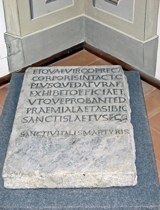


The earliest information about St Vitalis comes from an inscription [CIL XI 2 4966] that was originally in the church of San Lorenzo, Terzo della Pieve. It recorded a poem by Bishop Spes (ca. 380-410), in which he commemorated the fact that he had discovered the relics of St Vitalis and dedicated an altar to him.
Bishop Paolo Sanvitale (who probably had a particular veneration for "San Vitale") translated the relics and the inscription to the Duomo in 1597. The inscription was broken, probably during its translation but it is known from a transcription contained in a letter written by Paolo Sanvitale and from a fragment that is now in the Museo Diocesano and illustrated above:
SPES EPISCOPUS DEI SERVUS SANCTO VITALI MARTYRI
A SE PRIMUM INVENTO ALTARIS HONOREM FECIT
A W
MARTYRIS HIC LOCVS EST VITALIS NOMINE VERO
QVEM SERVATA FIDES ET CHRISTI PASSIO VOTAT.
SOLVS HIC E NOSTRIS VICTRICIA DONA REPORTANS
AETERNAM CAELO MERVIT PERFERRE CORONAM
HVNC PRECOR VT LVCIS PROMISSAE GAVDIA CARPAM
ET QVAE VIRGO PRECANS POSCIT CALVENTIA PRAESTET
CORPORIS INTACTO PVRI DECORATA PVDORE
PLVSQUE DATVRA FIDE DECORIS QVAM QVOD PIA PATRI
EXHIBET OFFICIA ET PVRO VENERATUR AMORE
VTQVE PROBANTE DEO MANEAT PER SAECLA FIDELIS
PRAEMIA LAETA SIBI CONCESSO MVNERE SVMME[NS]
SANCTIS LAETVS EGO SPES HAEC MVNVSCVLA (DONO ?)
SANCTI VITALIS MARTYRIS PASSIONIS NATALIS DIE XVI [KAL MARTIAS]
The line “ SOLVS HIC E NOSTRIS VICTRICIA DONA REPORTANS” (the only martyr among us) has been taken to mean that no other martyrs were venerated at Spoleto at the time of Bishop Spes. However, some scholars believe that the reference was to the specific location, now known as Terzo della Pieve, which might have been the personal property of Bishop Spes.
In the second part of the poem , Bishop Spes commended his daughter Calventia, a virgin consecrated to God.
The last line of the inscription gives the first part of the feast day as “XVI”. This has been assumed to be the surviving fragment of “XVI KAL MARTIAS” (14th February). Two saints named Vitalis are recorded in the martyrologies under this date:
-
✴The Hieronymian Martyrology records that St Vitalis was martyred with 84 soldiers at “Tuscia Spoliti”, near Spoleto . This probably post-dates the invention of the relics at Terzo la Pieve: it might derive from it, although that hypothesis does not explain the inclusion of the 84 soldiers.
-
✴An entry in the Roman Martyrology, on the same date, records: “Also at Rome, the holy martyrs Vitalis, Felicula and Zeno”. This seems to represent an absorption of St Vitalis of Spoleto into the legend of other martyrs that can be traced back to the Martyrology of Florus.
A relic of the tibia of St Vitalis in a reliquary (1597) commissioned by Paolo Sanvitale is now in the Cappella delle Reliquie in the Duomo.
Contemporary Translations
At least two other bishops made discoveries of relics in the late 4th century in circumstances very similar to those in which Bishop Spes discovered those of St Vitalis of Spoleto:
-
✴In 386, St Ambrose, Bishop of Milan, discovered the relics of SS Gervase and Protase and translated them to the new basilica that he had built in the city. The broadly contemporary biography of St Ambrose by the deacon Paulinus reports that “by the beneficent works of the martyrs [i.e. miracles worked by the relics], the faith of the Catholic Church increased, so did the heresy or the Arians decrease”.
-
✴In 392, Bishop Eusebius of Bologna discovered the relics of SS Vitalis and Agricola (4th November). St Ambrose attended the translation of the relics at Bologna and. according to the Roman Martyrology, deposited relics under consecrated altars. Paulinus records that St Ambrose built a church in Florence for some of the relics.
By discovering the relics of St Vitalis of Spoleto and translating them to a new altar, Bishop Spes seems to have been emulating St Ambrose.
A legend of St Vitalis (BHL 8690)is included under is on 28th April in the Leggendari del Duomo. This is a martyr who died at Ravenna: the date of his death is unknown but the first church on the site of his martyrdom was consecrated in 547. In the 8th century, he was wrongly identified as the father of SS Gervase and Protase.
For the historical background on Bishop Spes and his discovery of the relics of
St Vitalis, see the page on Early Christianity in Spoleto.
Return to Saints and Venerated Objects of Spoleto.

